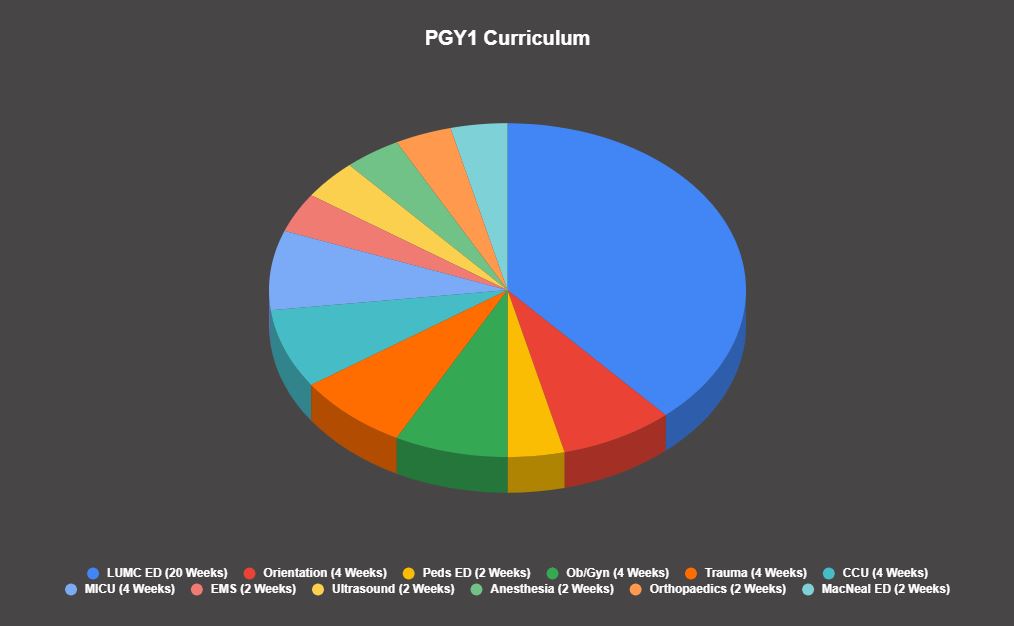PGY1 Rotations

LUMC ED: Based in Loyola’s Emergency Department, the PGY1 rotation will focus on learning the skills needed to be an effective & efficient EM team-member. You will work 1-1 with an attending physician to allow for dedicated teaching time.
Orientation: Loyola EM offers a full 4-week rotation at the beginning of the PGY1 year. Activities will include team-based learning exercises (didactics, simulation, etc) to build a level of knowledge that will allow for an effective introduction into our ED, team-building & social time to create an environment of family & support both within your class & with our faculty. There will also be ED shifts to allow for an introduction to our training environment.
Peds ED: In the PGY1 there will be a 4-week rotation early in the academic year, caring for pediatric patients in dedicated rooms in Loyola’s ED. After this rotation has been completed, you will be scheduled for 1-2 pediatric EM shifts during every ED rotation, to allow for longitudinal exposure.
OB: This 4-week rotation, will take place with our Ob/Gyn faculty & residents, allowing for the care of pregnant patients, and for the required deliveries as per ACGME guidelines.
Trauma: The PGY1 will function as a junior resident on the trauma service, caring for patients in our Level-1 Trauma ED, and on the inpatient side. You will learn the initial approach, work-up and management of trauma patients in a team-based setting.
CCU: During this 4-week rotation, the PGY1 will learn to care for the critically ill cardiovascular patients. Loyola is fortunate to have 24-hour in-house Interventional Cardiology, and also houses a dedicated LVAD service, allowing for access to patients that few programs can deliver.
MICU: Similar in design to the CCU rotation, the MICU rotation is 4 weeks in length, and will facilitate the learning and management of critically ill medical patients. Working on one of the 2 MICU teams, the PGY1 will function as a junior resident, and have dedicated teaching time with the MICU fellows & attendings.
EMS: Loyola EM is very closely affiliated with our EMS teams, with our Chairman acting as EMS Director. This rotation exists to give our PGY1s exposure to both ground & air crews, and provide opportunities to engage with our EMS staff in educational activities.
Ultrasound: This rotation will take place early in the PGY1s academic year, to allow for an introduction to the skills needed to be an effective bedside ultrasonographer. Our APD, Dr. Amy Kule, who is fellowship trained in Emergency Ultrasound, leads this rotation.
Anesthesia: Emergency airway management is a cornerstone of EM training. During this 2 week rotation, the you will spend dedicated 1-1 time in the OR with our Anesthesia colleagues mastering the skills needed for effective airway management, while also learning additional procedural skills under their guidance.
Orthopaedic Surgery: With LUMC being a Level-1 Trauma Center, our Orthopaedic service cares for a great number of acute fractures, dislocations and hand injuries. During this rotation the resident will help care for all of these patients, learn the skills required for effective bedside reduction and splinting, and advanced hand injury management skills.
MacNeal ED: MacNeal functions as our Community EM site, and is located in Berwyn, just a few miles West of LUMC. It is a high-volume and high-acuity ED, giving ample exposure to the acuity and procedures needed of a community site.